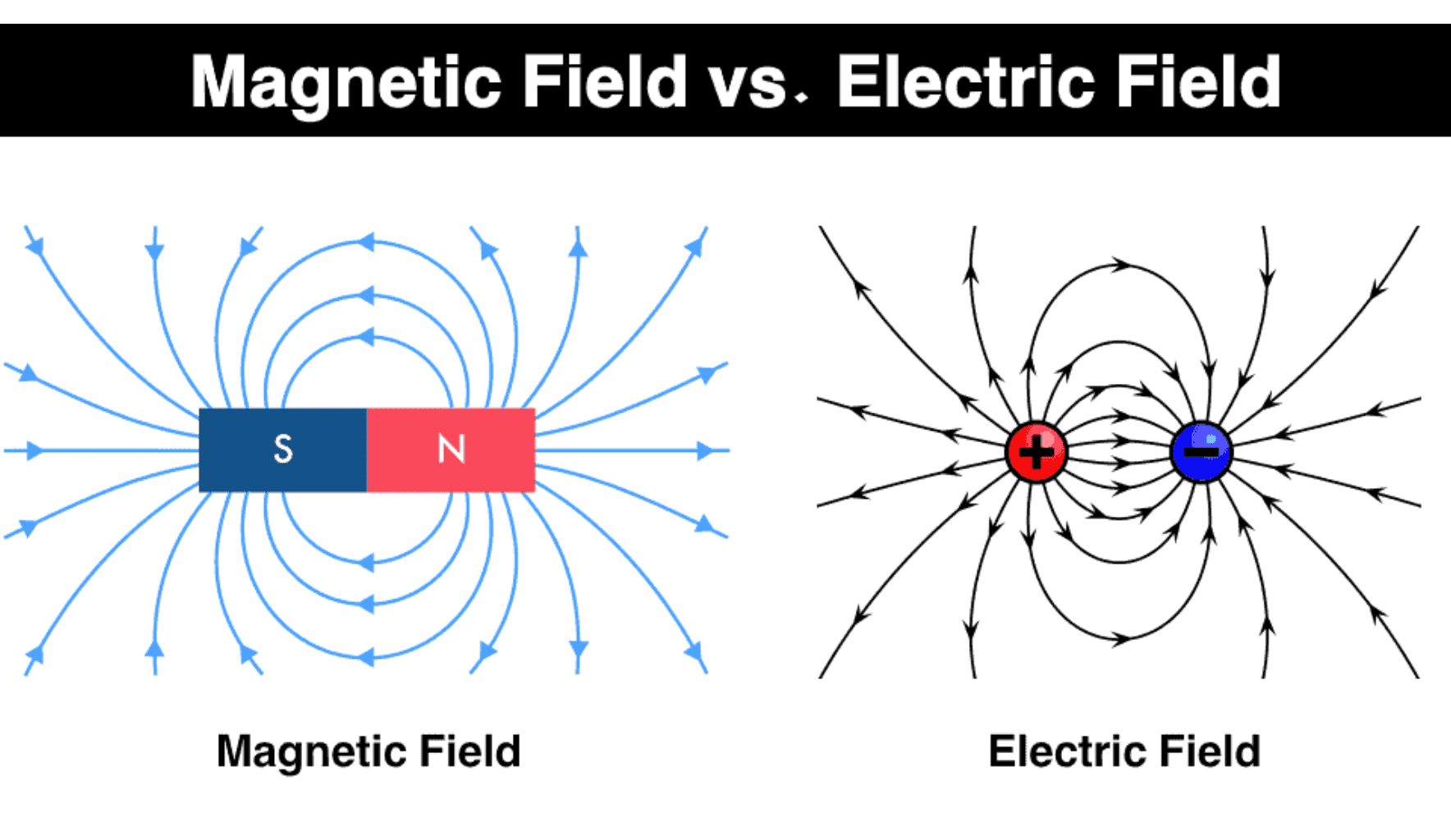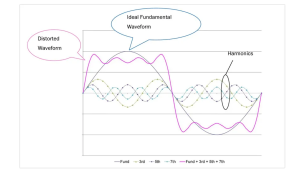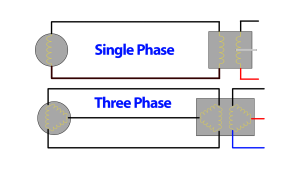The terms magnetic field and electric field are often thrown around haphazardly. Usually without understanding exactly what the differences are between them. This is not surprising; magnetic fields and electric fields are complex phenomena that act similarly in some ways. Though this is true, they are not the same things and need to be understood separately, as well as how they work when combined.

Understanding Magnetic Fields
A magnetic field represents the influence of magnetism at a point in space. It is a vector field, meaning it has both magnitude and direction. Magnetic fields are produced by moving electric charges, such as currents in a wire, and by the intrinsic magnetic moments of elementary particles associated with a fundamental quantum property called spin.
Sources of Magnetic Fields
Certain materials, like iron, cobalt, and nickel, can be magnetized to become permanent magnets. These materials contain microscopic regions called magnetic domains. In an unmagnetized material, the domains are randomly oriented. However, when magnetized, the domains align, producing a net magnetic field.

Source – researchgate.net
Alternatively we can also create magnetism to achieve the same thing using electricity. When electric current flows through a wire, it generates a magnetic field around the wire. This phenomenon allows for the creation of a temporary magnet, called an electromagnet, for as long as current is flowing through the conductor. When the conductor becomes de-energized the magnetism seizes. The right-hand rule helps determine the direction of this field: if the thumb of your right hand points in the direction of the current, your curled fingers show the direction of the magnetic field lines. Coiling the wire around an iron core amplifies this effect, creating a stronger magnetic field.

Properties of Magnetic Fields
Magnetic fields exhibit several distinct properties, each of which contributes to their behavior and interactions with materials. One fundamental characteristic of magnetic fields is that they are inherently dipoles. This means every magnetic field has two poles: a north pole and a south pole. These poles exhibit specific interactions; like poles repel each other, while opposite poles attract. This attraction and repulsion are foundational to the behavior of magnets and magnetic fields.
Another critical aspect of magnetic fields is the presence of magnetic flux lines. These lines are a visual representation of the magnetic field’s direction and strength. Magnetic flux lines emerge from the north pole of a magnet and curve around to enter the south pole, forming continuous, closed loops. The density of these lines indicates the field’s strength; closer lines signify a stronger magnetic field.


Magnetic fields also interact with materials in various ways, leading to their classification based on these interactions. Materials can be diamagnetic, paramagnetic, or ferromagnetic. Diamagnetic materials are those that exhibit a weak repulsion when exposed to a magnetic field. Examples include bismuth and copper. Paramagnetic materials, on the other hand, are weakly attracted to magnetic fields. This category includes materials like aluminum and platinum. The most significant interaction occurs with ferromagnetic materials, such as iron, cobalt, and nickel. These materials are strongly attracted to magnetic fields and can retain their magnetic properties even after the external field is removed. This retention occurs because the magnetic domains within ferromagnetic materials align in the direction of the magnetic field, and many remain aligned even after the field is removed, giving the material permanent magnetism.
Understanding Electric Fields
An electric field represents the influence of electric charges at a point in space. It is also a vector field and is described by the force exerted per unit charge at any point. Electric fields are produced by static electric charges or by time-varying magnetic fields, according to Faraday’s Law of Induction.
Sources of Electric Fields
A stationary electric charge produces an electric field that radiates outward in all directions. The strength of the field decreases with the square of the distance from the charge, meaning the field is strongest nearest the charge. This lone charge in a rest state is often considered “static,” which is where the terms static electricity and electrostatics come from.


Static electric fields are profound tools, however when we start moving electric charges things start to become even more interesting. According to Faraday’s Law, a time-varying magnetic field induces an electric field in nearby conductors. This principle is the foundation for many electrical generators and transformers.

Properties of Electric Fields
Electric fields exhibit several unique properties that define their behavior and interactions with charged particles and materials. One key concept is the electric dipole, which consists of two equal and opposite charges separated by a distance. These charges create electric field lines that emerge from the positive charge and terminate at the negative charge, illustrating the direction and strength of the field.
Another fundamental aspect of electric fields is their relationship with electric potential. Electric potential represents the potential energy per unit charge at a specific point within the field. When we talk about the potential difference between two points, we refer to it as voltage (E). This potential difference is crucial because it drives the movement of charges, resulting in electric current.
The interaction of electric fields with different materials further highlights their unique properties. Materials can be classified based on how they respond to electric fields. Conductors, such as metals, allow free movement of charge because their electrons are not tightly bound to atoms. This property enables conductors to transmit electric current efficiently. In contrast, insulators, like rubber or glass, do not permit free movement of charge because their electrons are tightly bound, preventing electric current flow. Semiconductors occupy a middle ground; they can conduct electricity under certain conditions, making them essential in modern electronics like transistors and diodes.
Interactions Between Magnetic and Electric Fields
Electric and magnetic fields are interconnected. A changing electric field generates a magnetic field, and a changing magnetic field generates an electric field. This interplay is described by Maxwell’s equations and forms the basis for electromagnetic waves, such as light.
Electromagnetic Induction
When a conductor moves through a magnetic field or a magnetic field changes around a conductor, an electromotive force (EMF) is induced, leading to an electric current. This phenomenon, known as electromagnetic induction, is the principle behind electric generators and transformers.
Lorentz Force
A charged particle moving through a magnetic field experiences a force perpendicular to both its velocity and the magnetic field, known as the Lorentz force. This force is responsible for the circular or helical motion of charged particles in magnetic fields and is a key principle in the operation of devices like cyclotrons and mass spectrometers.
Electromagnetic Waves
When electric and magnetic fields vary together in space and time, they propagate as an electromagnetic wave. These waves travel at the speed of light and include a broad spectrum of phenomena from radio waves to gamma rays. Electromagnetic waves are fundamental to modern communications, medical imaging, and many other technologies.
Conclusion
Magnetic fields and electric fields are fundamental components of the electromagnetic force, one of the four fundamental forces of nature. Their distinct properties and interactions underpin a wide range of natural phenomena and technological advancements. Understanding these fields, their sources, properties, and practical applications, is essential for fields as diverse as electrical engineering, physics, and medical technology. As our knowledge and technological capabilities expand, so too will our ability to harness and manipulate these fields for even more advanced and beneficial applications.
Interested in learning about how Electromagnetic Fields (EMF’s) and their effects on humans? Check out this article!






